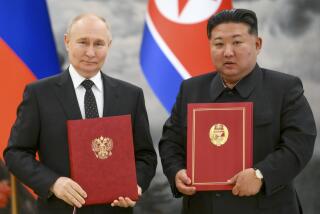N. Korea Is More Open, U.N. Says
- Share via
BEIJING — International aid groups operating in North Korea said Thursday that the isolated communist country had become slightly more open in recent months as economic reforms show modest signs of taking hold.
Humanitarian workers at a news conference here said the shift appeared to go beyond officials in Pyongyang and included school principals, hospital administrators and government workers, even in remote provinces.
“It manifests itself in many small ways,” said Richard Corsino, U.N. World Food Program director for North Korea. “You see it in the sort of questions you’re able to ask and the information you get on hunger and employment.”
An easing signal probably came from on high, aid workers said. North Korea maintains a cult around its leader, Kim Jong Il, who took over after his father died nearly a decade ago.
“In a country like [North Korea], people don’t suddenly wake up one day and decide to be more open,” Corsino said.
Representatives from five United Nations agencies appealed for $221 million in international aid to fund relief programs next year. About $192 million of that would go to the WFP to feed 6.5 million people, they said.
The good news, they said, is that North Korea’s economy has stabilized and its harvest is up for the third year in a row. There’s a local market in Pyongyang, more small enterprises, and more consistent power and water supplies, at least in big cities. There’s even a cellphone network. The government’s push to plant two cereal crops a year is yielding more food. And the number of malnourished children has dropped.
The bad news is that North Korea still faces major food shortages and extensive distribution problems, with adverse consequences for children and pregnant women. “One-third of mothers are still malnourished,” said Pierrette Vu Thi, UNICEF’s Pyongyang representative, and “70,000 children are still at immediate risk of death without hospital care.”
Though Pyongyang’s modest steps to ease wage and price controls have helped the economy, they have also made food more expensive. Donor countries, meanwhile, are less interested in giving aid because of political concerns and because of competing needs in Afghanistan, southern Africa and Iraq.
According to U.N. figures, the U.S. remains the largest aid donor to North Korea, contributing $31.1 million so far this year.
Aid workers said it’s hard to tell from inside North Korea that the country is in a global standoff over its self-declared nuclear weapons program. A second round of negotiations on the issue is tentatively set for mid-December in Beijing.
The humanitarian groups said that their view of changes in the country was by definition anecdotal and that they did not have any particular insight into the government’s thinking. But they’re now able to travel to 163 of North Korea’s 206 counties, they said, which contain 86% of the population. And even though trips must be approved in advance, workers said, they have wide latitude to travel within a province once they get there.
There number of trips rejected by the authorities has dropped sharply, they said, and the government is far more forthcoming with employment, health and malnutrition data.
“There are less barriers, and there’s much more willingness to share information than before,” said Eigil Sorensen, the World Health Organization’s representative in Pyongyang.
Reports persist that U.N. food aid is diverted to the military. Corsino said there was little doubt that Pyongyang’s first priority was to feed its soldiers.
But it does so with food aid from South Korea and China, he maintained, which place no restrictions on where the food goes, leaving the international community confident that its supplies were not being diverted.
More to Read
Sign up for Essential California
The most important California stories and recommendations in your inbox every morning.
You may occasionally receive promotional content from the Los Angeles Times.










